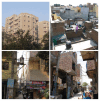Housing, health and energy: a characterisation of risks and priorities across Delhi's diverse settlements
- PMID: 39411509
- PMCID: PMC7616699
- DOI: 10.1080/23748834.2020.1800161
Housing, health and energy: a characterisation of risks and priorities across Delhi's diverse settlements
Abstract
Improved housing has the potential to advance health and contribute to the Sustainable Development Goals. Research examining housing, health and energy use in low-income countries is limited; understanding these connections is vital to inform interventions for healthy sustainable human settlements. This paper investigates the low-income setting of Delhi, where rapid urbanisation, a varied climate, high pollution levels, and a wide variation in housing quality could result in significant energy use and health risks. Drawing on approaches from health and the built environment and existing data and literature, a characterisation of energy use and health risks for Delhi's housing stock is completed. Four broad settlement types were used to classify Delhi housing and energy use calculations and health risk assessment were performed for each variant. Energy use is estimated to be nearly two times higher per household among planned housing compared with other settlement types. Health risks, however, are found to be largest within informal slum settlements, with important contributions from heat and particulate matter across all settlements. This paper highlights intervention priorities and outlines the need for extensive further research, particularly through data gathering, to establish evidence to accelerate achieving healthy, sustainable and equitable housing in Delhi.
Keywords: Delhi; Housing; India; energy use; health risks; intervention priorities.
Conflict of interest statement
Disclosure statement No potential conflict of interest was reported by the authors.
Figures




References
-
- Ahmad S, Choi MJ. The context of uncontrolled urban settlements in Delhi. Asien: The German journal on contemporary Asia. 2011;118:75–90.
-
- Akhtar R. Climate change and health and heat wave mortality in India. Global journal of environmental research. 2007;57(11):51–57.
-
- Akpinar-Ferrand E, Singh A. Modeling increased demand of energy for air conditioners and consequent CO2 emissions to minimize health risks due to climate change in India. Environmental science & policy. 2010;13(8):702–712. doi: 10.1016/j.envsci.2010.09.009. - DOI
-
- British StandardsInstitution. ISO 31010:2009 risk management: risk assessment techniques, London. 2010.
-
- Bureau of IndianStandards. National building code of India. 2005.
Grants and funding
LinkOut - more resources
Full Text Sources
